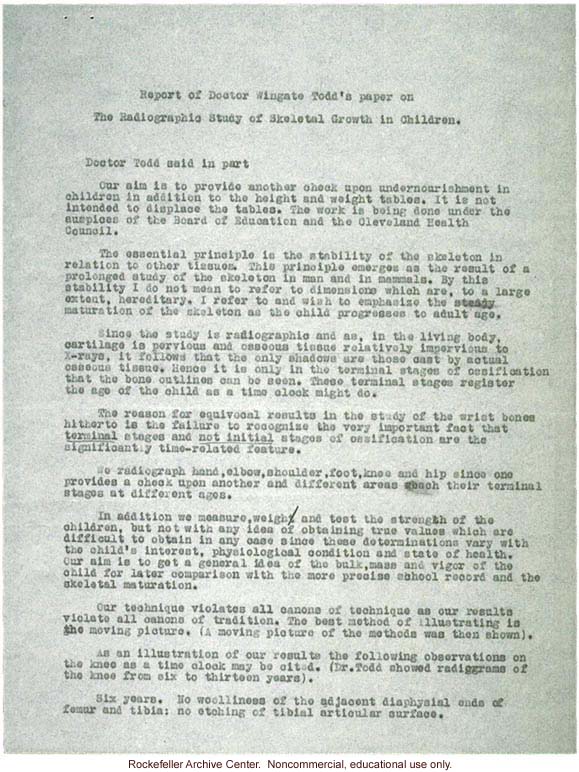Report of Doctor Wingate Todd's paper on
The Radiographic Study of Skeletal Growth in Children.
Doctor Todd said in part
Our aim is to provide another check upon undernourishment in addition to the height and weight tables. It is not intended to displace the table. The work is being done under the auspices of the Board of Education and the Cleveland Health Council.
The essential principle is the stability of the skeleton in relation to other tissues. This principle emerges as the result of a prolonged study of the skeleton in man and mammals. By this stability I do not mean to refer to dimensions which are, to a large extent, hereditary. I refer to and wish to emphasize the steady maturation of the skeleton as the child progresses to adult age.
Since the study is radiographic and as, in the living body, cartilage is pervious and osseous tissues relatively impervious to X-rays, it follows that the only shadows are those cast by actual osseous tissues. Hence it is only in the terminal stages of ossification that the bone outlines can be seen. These terminal stages register the age of the child as a time clock might do.
The reason for equivocal results in the study of the wrist bones hitherto is the failure to recognize the very important fact that terminal stages and not initial stages of ossification are the significantly time-related feature.
We radiograph hand, elbow, shoulder, foot, knee and hip since one provides a check upon another and different areas reach their terminal stages at different ages.
In addition we measure, weigh, and test the strength of the children, but not with any idea of obtaining true values which are difficult to obtain in any case since these determinations vary with the child's interest, physiological condition and state of health. Our aim is to get a general idea of the bulk, mass and vigor of the child for later comparison with the more precise school record and the skeletal maturation.
Our technique violates all canons of techniques as our results violate all canons of tradition. The best method of illustrating is the moving picture. (A moving picture of the methods was then shown).
As an illustration of our results the following observations on the knee as a time clock may be cited. (Dr. Todd showed radiograms of the knee from six to thirteen years).
Six years. No woolliness of the adjacent diaphysial ends of femur and tibia: no etching of tibial articular surface.


